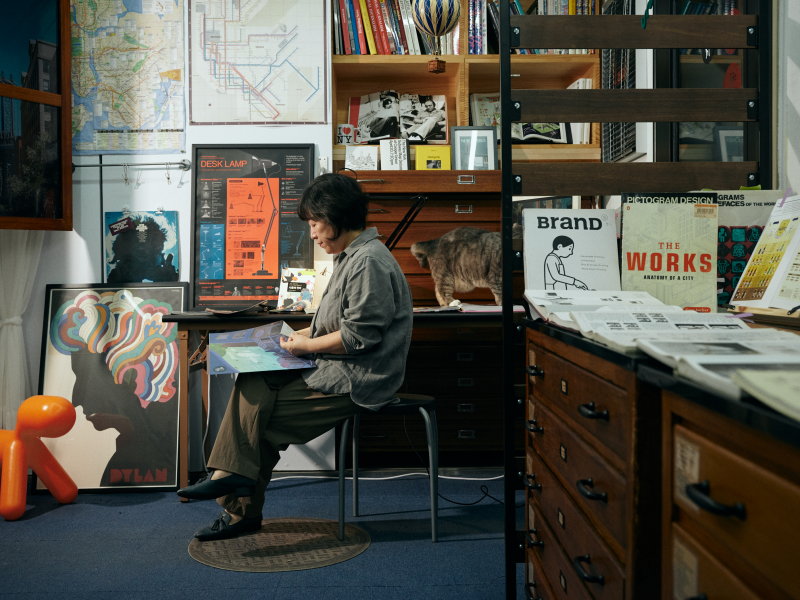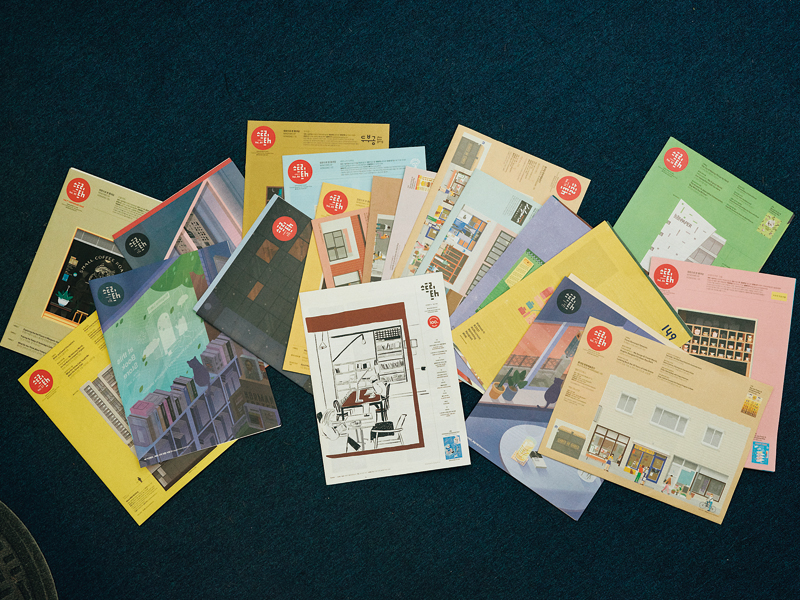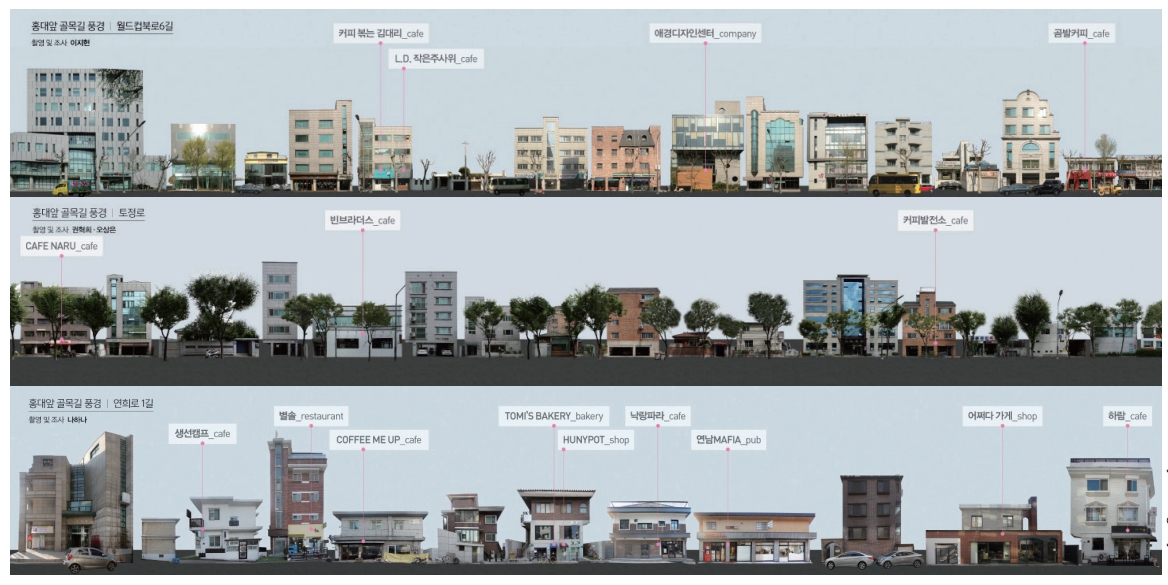Street H celebrates its 15th anniversary this year as the community chronicler of Hongdae. Although gentrification has reshaped the neighborhood, Jung Ji-yeon, editor-in-chief of the monthly magazine, believes the spirit of Hongdae is still very much alive.

After working for magazines and publishers for over 15 years, Jung Ji-yeon developed an interest in community magazines. In 2009, she started her own, Street H, to track the trendsetting changes in Hongdae.
Piles of tabloids and neighborhood-related pamphlets are seen everywhere in the office of Street H. For the past 15 years, the free monthly magazine has followed the ups and downs of a section of Seoul known as Hongdae, so named after a local institution , Hongik University. Once a haven for young, struggling artists, Hongdae now teems with art studios, clubs, cafés, and cultural spaces.
To residents and visitors, Street H is a must-read to stay up to date on Hongdae’s constant events and changes. Copies are distributed to information booths and select places, and it’s also available online (www.street-h.com).
Jung Ji-yeon is the magazine’s founder and editor-in-chief; she is also a Hongdae resident. Here she talks about her brainchild.
How has the magazine survived for so long?
Street H isn’t a commercial magazine based on advertisements. Had it been published with the sponsorship of clients or institutions, it would have easily lost momentum if financial support dried up. It also helped that the relationship with the local community grew extremely close after we passed the ten-year mark. Sometimes we first learn of local news through residents, other times Street H serves as a platform for opinions on important neighborhood issues.
What were the key changes in the area?
I define the period between 2005 and 2010 as the “emotional culture period.” This is when the indie band craze from the 1990s to the early 2000s subsided and many musicians playing acoustic guitars emerged. The romantic image of Hongdae in popular culture today, with cafés featuring wooden decor and busking performances, was d during this period. Many festivals were held as well. Street H was founded in June 2009, at this significant time.
What was the motivation behind the magazine?
In 2007, I was on a break and spent a year in New York after quitting my job at a publishing company. During that time, I often browsed local publications like L Magazine and Time Out and found their content to be highly relevant. I suddenly thought about creating a Hongdae-themed magazine in Korea. At that time, Hongdae was bursting with cultural diversity, so I thought it would be a very interesting subject.
You were concerned with Hongdae’s gentrification.
That’s true. Rents started to gradually rise in 2010. By 2013, articles about it started to appear, and around 2016, they weren’t talking about anything else. Hongdae lost some of its momentum. Its artistic atmosphere faded into one of entertainment, with dance clubs and food stalls popping up. Many franchise stores replaced the small, individual shops, all proving how popular the neighborhood had become.
Street H was aware that local media could be inadvertently contributing to gentrification. We had often published special editions focusing on specific neighborhoods like Yeonnam-dong and Mangwon-dong. After much thought, we decided against writing articles that sectionalize neighborhoods. We felt it was unnecessary to content that might entice real estate agents with information that you could easily find on social media.

Street H s Hongdae’s history, cultural activities, and major hubs. When it debuted, only a handful of Korean publications focused on such small areas. Now, it’s the most well-known local magazine in the country.
How do you select the places to write about?
I often say, “People places, and those places neighborhoods.” For a place to positively influence the neighborhood, the owners must have their own distinct content. There once was a café in Hongdae that was run by a former TV producer, and there’s now a bookstore run by a radio writer. While the number of such interesting places has sharply declined, there are still some around with such personal stories.
Low Books, for example, was opened by a former employee of a government research institution. She happened to visit an independent bookstore in Gyeongju and was so inspired that she decided to start her own with her younger brother. They run a book club among other programs, and I have no qualms about introducing that sort of place in our magazine. On the other hand, I usually avoid covering places that seem like outposts or testbeds for business expansion. The same goes for large franchise stores.
Who stands out among your 166 interviewees?
I often think about the late artist Park Seo-Bo, who passed away last year. It was back when he used to commute to his studio near Seongsan-dong. I had requested an interview, but he didn’t get back to me for quite a while. I had completely forgotten about it when he called one day and said, “I’m Park Seo-Bo. Come now.” I asked if I could come the next day, saying the photographer wasn’t available, but his response was, “No, if you come tomorrow, I won’t want to do it.” So, I went by myself with a camera and had so much fun interviewing him. Recently, the PARKSEOBO FOUNDATION contacted me to inquire about the photos I took that day.
It seems that Street H has become a public archive.
Aside from working for my magazine, I regularly take part in a Hongdae archiving group called ZINC. We mainly categorize events in Hongdae by year and topic. However, while events from the mid-1990s to the early 2000s are relatively well organized, bits and pieces are missing in the 20-year span from 2005 to the present. Whenever I research specific happenings from that period, everything I want to know can be found in Street H.

Thanks to meticulous research and photographic records, the back issues of Street H are an archive of enlightening information about the Hongdae area.
Courtesy of Jung Ji-yeon
What are your thoughts about the Hongdae of today?
Hongdae has been called a “dead neighborhood” for some time now. However, there are still people who love this place. One man said the area shaped his attitude towards life. You could say the Hongdae spirit lives on. For example, Sukkara, a café that was in Hongdae for over 10 years, offered home-cooked meals made from seasonal vegetables and native agricultural products. Although it’s now closed, the owner d Marché@, a farmers market that’s going strong in various locations around Seoul.
I believe that the spiritual legacy and infrastructure of the people who pioneered a new culture in the Hongdae area still have strong roots. Even though the cultural core may not be the same as before, experimental ventures continue to this day.
As a Hongdae resident, what would you brag about?
I live at the edge of the Gyeongui Line Forest Park. There was nothing there at first, but recently it has become a comfortable place to live with the new subway line and the park. I enjoy the leisurely 45-minute walk from my home to the office and feel that this neighborhood falls right in line with the 21st century lifestyle of putting a greater emphasis on nature.